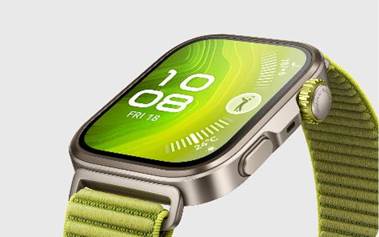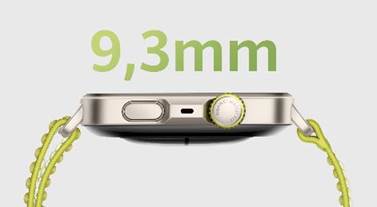Wearables
make it easier to be productive. They keep track of your behaviors, remind you
of responsibilities, and help you stay organized without having to pull out
your phone. From workouts to meetings, these smart devices improve daily
efficiency. More individuals rely on them to manage their time and health.
Smartwatches and fitness trackers are no longer simply for counting steps; they
are becoming indispensable tools for both work and home. Wearables, with
real-time notifications, habit tracking, and fast access to crucial
information, provide a convenient method to stay focused and save time
throughout the day.

What Are Wearables and How Are They Used Today?
The Rise of Smartwatches and Fitness Trackers
Smartwatches
and fitness trackers have progressed from niche items to household necessities.
People wear them for more than just health monitoring; they also manage
communications, reminders, and daily planning. Brands continue to add
functionality, making these devices more than just step counts. Many now
feature voice assistants, GPS, and smart sensors. The Huawei Watch Fit 4 Pro,
for example, combines a stylish design with robust tracking and productivity
features. Wearable usage is increasing as more people value wellness and
efficiency. These technologies address the demand for smart, small tools that
make life easier while encouraging healthy habits.
Popular Productivity Features in Wearables
Wearables
include gadgets that increase productivity. Smart notifications ensure that you
do not miss meetings or correspondence. Built-in voice assistants allow users
to create reminders and send texts hands-free. Many gadgets provide to-do
lists, calendar synchronization, and real-time collaboration capabilities. Some
even enable speedy responses to communications or interaction with virtual
conference systems. Users may also operate smart home devices and listen to
music while working. With haptic alerts, you may keep informed without
disrupting your flow. These services work together to help users remain on
schedule and complete more tasks, no matter where they are.
Wearables at Work vs. Personal Life Usage
Wearables
in the workplace assist employees in managing activities, monitoring stress
levels, and responding swiftly to communications. In remote work, smartwatches
serve as little command centers for email, calendar, and reminders. Users
personally measure their steps, sleep, and water to be healthy. Devices such as
the Huawei Watch Fit4 Pro bridge the gap, providing benefits for both
productivity and wellness. Many professionals rely on them to stay on track
during meetings and productive during commutes. Outside of work, these tools
help you achieve your physical objectives and maintain mental clarity. Modern
wearables' dual functionality makes them perfect companions for work-life
balance and daily organization.
How Do Wearables Improve Time Management and Focus?
Calendar Alerts and Smart Notifications
Calendar
alerts on wearables help to prevent missed appointments and last-minute stress.
Users receive modest nudges before meetings or assignments to help them stay on
time. Smart notifications highlight just the most important information,
removing distractions from less urgent communications. Devices can sync with
Google Calendar, Outlook, and other productivity tools. The Huawei Watch Fit 4 Pro smartwatch, for example, displays essential reminders and
future events at a glance. This offers an efficient loop of updates that does
not require continual phone checking. When crucial chores arise at precisely
the right time, time management becomes easier. These features improve day
planning and mental focus, particularly for busy professionals juggling various
responsibilities.

Distraction Blocking and Focus Timers
Many
wearables now have distraction management features. Focus clocks, such as the
Pomodoro technique, help you divide work into small, productive spurts. During
these sessions, the wearable can turn off non-essential notifications to
minimize interruption. Some have "focus modes" that completely pause
alarms. To avoid burnout, these methods encourage planned work periods
interspersed with brief pauses. The idea is to assist people stay focused on
one task at a time. With wearable help, staying focused becomes a more
achievable and constant habit. It's a simple approach to train attention and
boost productivity without relying simply on willpower.
Hands-Free Access to Essential Tools
Wearables
allow you to access tools without grabbing your phone. Voice commands,
quick-reply tools, and app shortcuts enable users to take action immediately.
Whether you're responding to messages, setting a timer, or checking your
calendar, everything is at your fingertips—or wrist. The Huawei Watch Fit4 Pro,
for example, allows you quick access to voice assistants and business apps via
simple gestures. This frees up your hands for chores such as driving, cooking,
and taking notes. Staying productive does not always imply working more; it
might also entail reducing barriers to action. Wearables allow consumers to
respond quickly and stay on track throughout the day.
Can Wearables Help You Build Better Habits?
Step Tracking and Movement Reminders
Step
monitoring lets people realize how active they are throughout the day.
Wearables track success toward daily movement targets, which promotes
consistency. Most have movement reminders, which gently advise users to stand
or walk if they have been sitting for too long. These reminders promote good
posture and circulation. Wearables, which include features such as visual
progress rings and vibrating nudges, make daily activity a fun, measurable
challenge. The Huawei Watch Fit4 Pro provides accurate tracking and
personalized nudges to keep users moving. Wearables encourage minor changes
that lead to increased energy and attention by incorporating wellness into your
daily routine.
Sleep Monitoring and Rest Optimization
Wearables
monitor sleep quality to assist people in improving their sleeping patterns.
Most devices track duration, heart rate, and sleep cycles. Some provide
individualized advice, such as recommended bedtime ranges or wind-down
reminders. When users wake up, they see detailed information on how well they
slept and advice on how to improve recovery. The Huawei Watch Fit4 Pro features
comprehensive sleep tracking, including insights into deep sleep and REM
periods. Rest is essential for productivity, and wearables make it simple to
track without effort. Over time, people get a better understanding of how rest
influences their day and can make more informed decisions for long-term energy.
Goal Tracking and Daily Progress Reports
Wearables
enable users to create and achieve personal goals. Whether it's drinking more
water, meditating, or exercising frequently, sensors monitor progress in real
time. Visual dashboards inform customers how near they are to meeting daily
targets, encouraging consistent action. Daily reports provide insight into
patterns, allowing for the refinement of processes. The Huawei Watch Fit4 Pro
succeeds here, providing concise summaries and weekly trends. Seeing modest
victories every day generates momentum. These digital trackers serve as
personal trainers, providing encouragement and data to keep users going
forward. Goal-setting becomes simpler, and habit-building becomes a more
satisfying, data-driven endeavor.
What Should You Look For in a Productivity-Focused
Wearable?
Battery Life and Device Compatibility
A
wearable's battery life affects its dependability on a daily basis. More
continuous tracking and fewer disruptions are the outcomes of a longer-lasting
battery. While most smartwatches have a one to two-day battery life, others
have longer lifespans. Additionally, devices should be compatible with your
calendar, business apps, and phone. The huawei watch fit4 pro is compatible
with both iOS and Android and has a long battery life. Because of its deep
integration and reliable power, users don't have to worry about their wearable
missing a beat. Give priority to devices that will not die in the middle of the
workday and are compatible with your digital ecosystem.
App Integrations for Work Tools
Wearable
productivity devices should integrate easily with your most often-used tools.
The more integrations accessible, the smoother your workflow will be. Smart
notifications and app controls let you handle chores, take calls, and get
updates directly from your wrist. The Huawei Watch Fit4 Pro supports a variety
of platforms, making it excellent for those who manage work across different
apps. The built-in compatibility makes transitioning between meetings, tasks,
and discussions much easier. Integrations transform a simple watch into a
command center for your workplace.
Comfort, Design, and Ease of Use
Comfort
is an important factor in deciding whether to wear a device on a daily basis.
Lightweight design, adjustable straps, and an easy-to-use screen all make a
difference. Look for wearables with user-friendly menus, easy controls, and a
clear display. The Huawei Watch Fit4 Pro has a stylish design, a user-friendly
interface, and a lightweight construction, making it ideal for all-day usage. A
comfy device will not distract or irritate you while working or sleeping. If
it's also fashionable, you're more likely to wear it. Function and fashion
should complement each other to create a cohesive experience.
Conclusion
Wearables
have grown into more than just fitness gear; they are now full-scale
productivity tools. They keep users focused and organized by providing smart
alarms, time-monitoring tools, and easy access to work apps. Tools like the
Huawei Watch Fit4 Pro demonstrate how far wearables have progressed, with
capabilities that support both professional and personal aspirations. These
devices help people manage their time and avoid distractions, as well as
measure their sleep and develop habits. When selecting a wearable, consider
comfort, compatibility, and battery life. With the appropriate device, anyone
can streamline their day, decrease stress, and do more with less effort.
Wearables genuinely enable smarter and healthier productivity.
